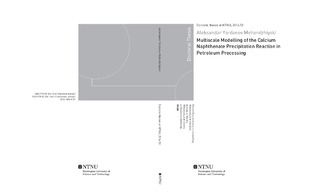| dc.contributor.advisor | Grimes, Brian A. | |
| dc.contributor.advisor | van Erp, Titus S. | |
| dc.contributor.author | Mehandzhiyski, Aleksandar Yordanov | |
| dc.date.accessioned | 2016-03-17T11:19:44Z | |
| dc.date.available | 2016-03-17T11:19:44Z | |
| dc.date.issued | 2016 | |
| dc.identifier.isbn | 978-82-326-1445-5 | |
| dc.identifier.issn | 1503-8181 | |
| dc.identifier.uri | http://hdl.handle.net/11250/2382386 | |
| dc.description.abstract | The formation of calcium naphthenate precipitates occurring in the petroleum industry is both an undesirable side reaction and can introduce costly shutdowns and cleaning processes. Although the reaction has been studied by experimental techniques, the exact mechanism of reaction and precipitation is still under debate. In the present work, we apply a multiscale approach to study the formation of calcium naphthenate precipitates. To systematically study this otherwise complex reaction influenced by many factors, we first have applied density functional theory (DFT) calculations on the interaction energies between carboxylate anion(s) and calcium and sodium cations. The influence of the multibody effects have been determined by DFT and their impact on the commonly used OPLS-AA force field is assessed. It has also been indicated that the calcium ion can coordinate up to four carboxylate molecules. The lowest interaction energy has been reached when calcium interacts with 3 carboxylates. A comparison between DFT and OPLS-AA shows satisfactory representation of the carboxylate - calcium interactions by the force field, which has been further used to study the calcium naphthenate precipitation reaction. The calcium naphthenate reaction has been shown to be very selective and calcium is the most abundant cation in the precipitates amongst all the divalent cations. To address this observation ab initio molecular dynamics simulations have been performed to understand the basic mechanism of the carboxylate - metal ion dissociation in water. By thermodynamic integration we have evaluated the free energy of interaction between propanoate anion and the divalent Mg2+, Ca2+, Sr2+ and Ba2+ cations. This study revealed that the strongest interactions of the carboxylate anion are with magnesium followed by calcium, strontium and barium, which partially explains the selectivity. However, magnesium shows also the strongest interactions with the solvent molecules, which has affected their dynamics. The dynamics of the solvent molecules together with the self-diffusion of the divalent ions infer that calcium most likely will bind with the carboxylate rather than magnesium. The preferred binding with calcium has been further complimented by calculating the probability for reaction between two carboxylates and one divalent metal cation as a function of the distance separating the carboxylates. That has been achieved by performing molecular dynamics (MD) simulations together with umbrella sampling. The probability of reaction has been finally used as a constituent function in the method development for recreating the interfacial density of tetracarboxylic acid (TA) molecules to calcium naphthenate precipitation. This method involves MD simulations of TA molecules at an oil-water interface for obtaining different probability distributions from the simulation trajectories describing their molecular orientation and structuring. Then the MD simulated probabilities are used to recreate the interfacial density in a coarse-grain manner from which we have determined the fractional conversion of TA molecules to calcium naphthenate precipitation as a function of the interfacial concentration. The fractional conversion is shown to increase non linearly with the increase of interfacial concentration. | nb_NO |
| dc.language.iso | eng | nb_NO |
| dc.publisher | NTNU | nb_NO |
| dc.relation.ispartofseries | Doctoral thesis at NTNU;2016:53 | |
| dc.relation.haspart | Paper 1:
Mehandzhiyski, Aleksandar Yordanov; Riccardi, Enrico; van Erp, Titus Sebastiaan; Koch, Henrik; Åstrand, Per-Olof; Trinh, Thuat; Grimes, Brian Arthur.
Density Functional Theory Study on the Interactions of Metal Ions with Long Chain Deprotonated Carboxylic Acids. Journal of Physical Chemistry A 2015 ;Volum 119.(40) s. 10195-10203
<a href="http://dx.doi.org/10.1021/acs.jpca.5b04136" target="_blank"> http://dx.doi.org/10.1021/acs.jpca.5b04136</a>
Reprinted with permission. (c)2015 American Chemical Society. | |
| dc.relation.haspart | Paper 2:
Mehandzhiyski, Aleksandar Yordanov; Riccardi, Enrico; van Erp, Titus Sebastiaan; Trinh, Thuat; Grimes, Brian Arthur.
Ab Initio Molecular Dynamics Study on the Interactions between Carboxylate Ions and Metal Ions in Water. Journal of Physical Chemistry B 2015 ;Volum 119.(33) s. 10710-10719
<a href="http://dx.doi.org/10.1021/acs.jpcb.5b05616" target="_blank"> http://dx.doi.org/10.1021/acs.jpcb.5b05616</a>
(c)2015 American Chemical Society. | |
| dc.relation.haspart | Paper 3:
Mehandzhiyski, Aleksandar Yordanov; Grimes, Brian Arthur.
Calculation of the probability for ionic association and dissociation reactions by molecular dynamics and umbrella sampling. Molecular Physics 2016
<a href="http://dx.doi.org/10.1080/00268976.2016.1155776" target="_blank"> http://dx.doi.org/10.1080/00268976.2016.1155776</a>
" The Version of
Record of this manuscript has been published and is available in
Molecular Physics Volume 114, Issue 11, Published online: 03 Mar 2016
http://www.tandfonline.com " | |
| dc.relation.haspart | Paper 4:
Mehandzhiyski, Aleksandar Yordanov; Grimes, Brian Arthur.
Coarse-Grained Interface Surfactant Density Maps for Calculation of the Fractional Conversion of Tetrameric Carboxylic Acids to Calcium Naphthenate Precipitates. Industrial & Engineering Chemistry Research 2016 ;Volum 55.(17) s. 5090-5099
<a href="http://dx.doi.org/ 10.1021/acs.iecr.5b04624" target="_blank"> http://dx.doi.org/ 10.1021/acs.iecr.5b04624</a>
(c)2015 American Chemical Society. | |
| dc.title | Multiscale Modelling of the Calcium Naphthenate Precipitation Reaction in Petroleum Processing | nb_NO |
| dc.type | Doctoral thesis | nb_NO |
